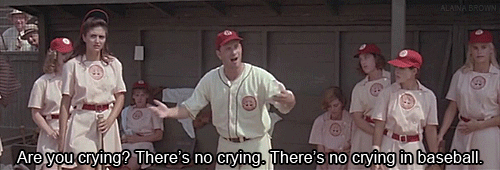feature image via shutterstock.com
When I was maybe 7 years old, I sat by the backstop behind home plate at my older sister’s softball game and willed myself to sob. Sitting in the dirt, my child-brain was tired of always feeling overwhelmed, feeling like most any badness or evil or sadness in the world made me cry or hurt my heart.
Plus, my parents, who were wrangling five daughters all within 12 years of age, didn’t have much time for emotional coaching. If I was crying, I would be taken less seriously; babies cry, and they’re babies, you know?
I decided right then at the softball game that I would cry out all my tears. That, I figured, was the only solution: Open the floodgates for the last time, and surf that wave into what I believed would be a tearless, tougher-hided future.
My mom asked me why I was crying then, and I told her. I don’t remember what she said in response.

I was always a sensitive, anxious kid, terrified the evils of the world would somehow find my sisters or my parents and there would be nothing I could do about it. Worries of kidnappers plagued me, and my mom would hold my lanky kid-body and rock me, telling me that all the worry only makes the bad guys win, all we can do it take it a day at a time and be safe.
Looking back, this story shows how big and tender my heart was then, and how closed off it has now become. In my later teens and early 20s, as I started to understand my lack of interest in my high school boyfriends had nothing to do with them, not really. I learned quickly and painfully to compartmentalize, to put away the new, big feelings that threatened to overwhelm me. It was as natural as breathing to start building those walls, to start protecting myself the only way I could.
My first two years in college were a big experiment in finding out what I could and couldn’t handle. I was calm, cool and proactive when a friend told me she was cutting, or another told me she’d been raped, but I heard tornado warnings in my head when I realized my romantic feelings for other women weren’t going away. Eventually, like many of you, I had to turn to face the storm sometime. Coming out was painful — it’s a future topic to be discussed at length— and my defensive response was to shut down, clam up, and not feel.

While necessary at the time, that particular emotional evolution stuck around for longer than 10 years, and I paid it devotional attention. Building walls and sealing cracks was easier than letting people in to see and poke at my soft spots, my vulnerabilities. At the time it was great – probably saved my life, frankly – but once those external pressures faded and my life settled into a calmer, more honest space, I realized that thick, hard-candy shell I’d developed wasn’t going anywhere unless I actively dismantled it.
Mind you, this realization only came about after four years with the same therapist, setting up emotional scenarios and knocking them down, one by one, day by day. We worked to a place that felt like I was finally able to get a bird’s eye view of my maze of emotional masonry, and the extent of it all. I could realize I was only allowing a tiny stream of emotions through a crack in my walls, one that I could control and shut down any time. But the fullest feeling I could get was only the size of that tiny trickle, and this included the good, big ones like love, happiness, or joy.
Which brings us here. My therapist told me, not unkindly, that I am a feelings rookie and gave me a paper list of emotions, because I have a blind spot when it comes to identifying what I’m actually feeling until that feeling is at a *Level 10 Alert*. My job now is to take this list and think about how I feel, and what that means, really. There are many ways to go about this, of course, but one mechanism that works for me is exploring through writing and discourse, connecting dots I didn’t know were there.

Yes, this is one of the ways children learn about feelings, and yes, there was some shame about this process, like I was somehow less than for not being able to understand what others seem to handle without much thought, that the only way to better myself is to use methods used on kids. I felt demoralized for a while, ashamed of my shortcomings, but then I thought about that a little bit, and realized that taking on this process with intention is the most adult thing I can do.
But since I hate them for pushing my comfort zone, I don’t call it discovering feelings or celebrating feelings. This is Dealing with Feelings, the shiny bare bones of learning, naming, and surviving emotions. I’m going to chronicle my discoveries and frustrations and tears and hopefully joy that I stumble upon in this journey into feelings, and hopefully also connect with you on yours.
For many of us, shutting down and building up walls was an essential coping skill — if our home lives as gay kids were tough, that armor kept us safe and alive. But those walls don’t just break down when you stop needing them, and suddenly what was keeping you safe is now hindering personal development. It blows. It’s a whole process of demolition and rebuilding and relearning what all these feelings are, and it is awful and glorious in equal turns.
I want to make feelings accessible, because for so long they weren’t for me. Because at the core of it all, I believe many of us who struggle with this do it under the heavy weight of the assumption we are alone, we are the only ones who can’t get it together. But that’s not true – we don’t have to sit behind softball field backstops trying to pull from ourselves the best and worst parts of being human.
Bring it, feelings. Here we go.







